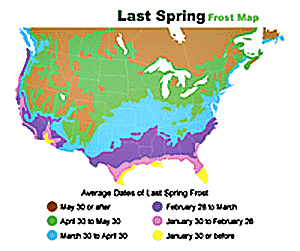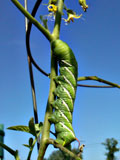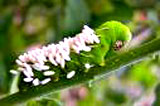Gardeners' Help and Tips
When is the right time to plant tomatoes? Is that a good bug or a bad bug crawling on my cabbage leaf? What should I be doing now? Gardeners have many questions and seasoned gardeners are always willing to share their tips.
This page attempts to answer some of the burning questions that you might be facing.
There is a wealth of information on the internet about regional zones and frost dates. Chelmsford is currently classed as zone 6, although be aware that since we are located in the Merrimack valley which mostly runs north-south, and on an open field, colder air might affect our local climate. Zone 5 plantings would be less risky if you are considering perennials for your garden. The following information is from the Dave's Garden website:
Each winter, on average, the risk of frost is from September 26 through May 11.
Almost certainly, however, there will be frost from October 13 through April 28.
There is unlikely to be frost from May 24 through September 9.
The frost-free growing season is around 138 days.
General Last Spring Frost Zones

In New England, people generally plant out their warm season crops (tomatoes, peppers, eggplants, beans etc) after Memorial day. Frost protection may still be required for overnight dips for the rest of the month. It is important to track the overnight temperatures for the Chelmsford zip code.
Winter Plant seeds of long-season crops indoors in pots or cell packs before the last frost date in your area in Chelmsford. Start tomatoes, peppers, and eggplants 8 weeks early, cole crops about 4 to 6 weeks early, and vine crops 1 week early.
Early Spring/Fall Eliminating weeds and getting the soil ready for your flowers and vegetables are important first steps in growing a successful garden. Time spent in preparation reduces the time you'll have to spend maintaining and weeding your garden over the course of the growing season.
Use black plastic mulch to warm the soil in spring and to retain extra heat in fall. Cover the edges of the plastic with soil to anchor it in place.
Start and end the gardening season with cold-hardy vegetables that tolerate frost, such as peas, lettuce, cole crops, beets, and chard. Some vegetables also have particular varieties better suited to grow in cold, short-day climates. Other varieties are specially adapted to growing in long, hot days, extending your growing season into the summer. Read seed packets and catalog descriptions to find vegetables that meet your particular needs.
Cover early and late season plantings with mini-greenhouses made from clear plastic containers, old window sashes set on hay bales, or purpose-made fabric row covers. Vent the covers on warm days to prevent excessive heat buildup.
Extend your harvest into fall by planting second crops of short-season vegetables, such as snap beans, peas, greens, radishes, cole crops, and turnips later in the season timed so they mature during the cooler weather in the fall.
Watering is best done early in the day and at the base of plants to reduce transmission of plant diseases and burn due to wet leaves in strong sunlight. Evening watering is the second-best time to water, since warm overnight temperatures at this time of year can encourage fungal diseases in plants. Watering during mid-day hours should be avoided if at all possible. Cool water on hot soil can stress plants and more water is lost due to evaporation than at other times.
Moisture Provide adequate soil moisture throughout the growing season to help fast-growing plants establish strong roots and produce fruit. The most critical times are just after planting and as the desirable edible part is forming. Keep the top 6 inches of soil moist for seedlings and young plants. Once plants become established, encourage deep rooting by wetting the soil at least 6 inches deep when the top 3 to 4 inches feel dry.
Mulch Organic mulches such as pine needles, shredded leaves, grass clippings from untreated lawns or straw moderate soil temperature, preventing hot and cold extremes. Add a 2- to 4-inch layer of organic mulch around your vegetable plants to suppress weeds, maintain soil moisture, reduce watering, moderate soil temperature, improve soil health, and keep vegetables cleaner. Avoid herbicide-treated lawn clippings, hay, and fresh sawdust and manure. Apply mulch after the soil has warmed in spring and replace as needed.
Weeds Pull or hoe weeds as soon as they appear and while they are small. Never allow weeds to go to seed in your garden. Maintain mulch to suppress them. Remove crowded seedlings-especially carrots, radishes, onions, and beets-as soon as possible to give the remaining crop enough space to mature.
Bug Patrol Check early and often for bugs. Familiarize yourself with beneficial and nuisance bugs and best organic methods for control.
Feed Each vegetable crop has unique nutrient needs throughout the growing season. Natural soil texture and fertility also play a role in when and how much additional fertilizer plants need. In general, you can fertilize transplanted vegetables (tomatoes, peppers, eggplants, head lettuce, and cole crops) and corn about 3 to 4 weeks after planting. Some crops may need additional fertilizer later in the season. Fertilize vine crops (melons, cucumbers, and squash) when the vines begin to spread and again when they bloom. Sprinkle fertilizer 6 to 8 inches from stems and scratch into the soil.
Harvest Pick vegetables when young and tender for the best flavor and to keep the plants producing. If seeds begin to mature inside beans, peas, cucumbers, and summer squash, the plants will stop making new fruits. Harvest leaf crops (lettuce, spinach, and chard) by cutting to within 2 inches of the ground to encourage young, new leaves to grow. Pull root crops as needed for meals as soon as they reach edible size. Pulling every other root as they grow leaves room for expansion for the ones that are left.
To prevent the spread of disease, don't work in the garden when the plants are wet.
Nitrogen encourages leafy growth, often at the expense of flowers and fruit. Don't use high-nitrogen fertilizers on tomatoes, peppers, and eggplants prior to flowering.
The best time to eliminate weeds and grass is the season before you plan to plant your garden. Removing all plant material and digging over your bed at the end of the season makes it easier to prepare and plant earlier in the spring. You can do it just prior to planting, too, but you may have more weeds pop up throughout the growing season, and you will be later getting your early season crops planted out.
 Rogues Gallery
Rogues Gallery Beneficial Bugs
Beneficial Bugs